USING TECHNIQUES AND TACTICS IN SPARRING
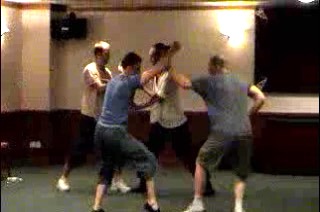
Participants enjoy themselves using combat sequences in their sparring
In Combat Sequences 1 to 4 shown in previous video series, the focus is on developing basic combat skills like right spacing, right timing, fluid movements, energy flow and mental clarity. In Combat Sequences 5 to 8 shown in the video series here, the focus is on expanding the repertoire of combat techniques.
Sparring skills are further developed. At this stage of our sparring methodology, while the movements are not predetermined, they are also not totally free. Control is gradually released, and course participants are given appropriate guidelines so they can effectively apply kungfu skills, techniques and tactics in attack and defence spontaneously. By the end of this stage, participants can effectively handle any hand attacks.
A question commonly asked is whether the participants can still be as effective if their opponents use other martial art techniques or fight randomly. The answer is yes.
Unless these opponents are very skillful, fighting them would be technically easier than fighting those who use kungfu techniques. The reason is actually straight-forward. Kungfu techniques are relatively more sophisticated, and kungfu practitioners consider factors like tactical planning, breath control and safe coverage that most other martial artists may take for granted. But this does not mean a kungfu practitioner will necessarily win in a fight. If the opponents are faster or more powerful, for example, they can beat the kungfu exponent despite their lesser techniques and tactics.
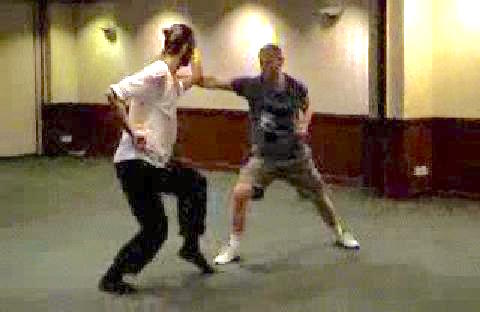 Sequence 5: Fierce Tiger Speeds Through Valley
Sequence 5: Fierce Tiger Speeds Through Valley
This is Combat Sequence 5. Note that the initiator uses both the right hand mode and the right leg mode. The pattern is called “Fierce Tiger Speeds Through Valley”. This sequence is also called “Fierce Tiger Speeds Through Valley”, named after the first pattern of the sequence. It introduces the tactic of “pressing attack”.
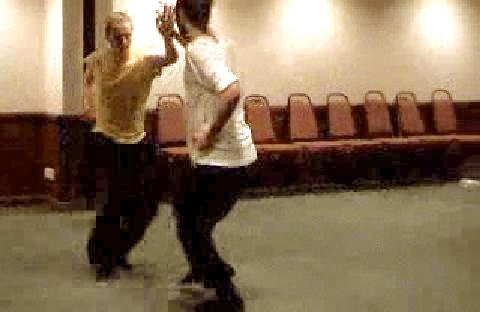 Sequence 6: Dark Dragon Draws Water
Sequence 6: Dark Dragon Draws Water
This is Combat Sequence 6, and is called “Dark Dragon Draws Water”. The counter against this attack is functionally beautifully and its effect comes from waist rotation, and not moving the hands. It deflects the attack, not blocks it, then counter-strikes often before the opponent is aware of it.
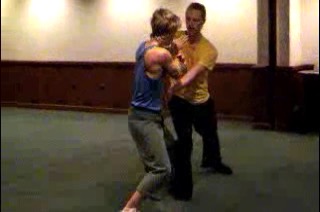 Applying Sequence-Continuatuin in Sparring
Applying Sequence-Continuatuin in Sparring
With an enlarged repertoire of techniques, the participants have more variety in the application of the sequence-continuation method. The initiaor, for example, starts with Sequence 6 and continues with Sequence 5.
 Sequence 7: Chop the Hua Mountain
Sequence 7: Chop the Hua Mountain
This is Sequence 7, and is called “Chop the Hua Mountain”. The chopping attack should be flexible, with the arm acting like a chain rather than a rod. The counter is marvelous. If executed skillfully, it intercepts the chop and strikes the attacker before his attack has completed its course.
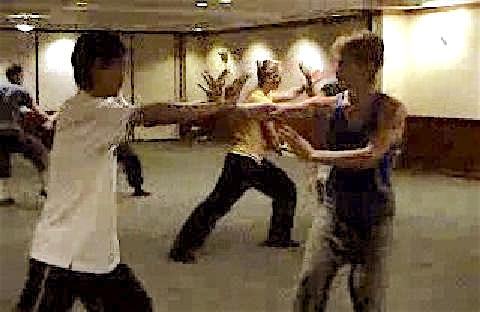 Skills are More Important then Techniques
Skills are More Important then Techniques
Participants employ the method of sequence continuation in their sparring, and are spontaneous and effective in their movements. Many practitioners may not realise that skills contribute more to combat efficiency than techniques.
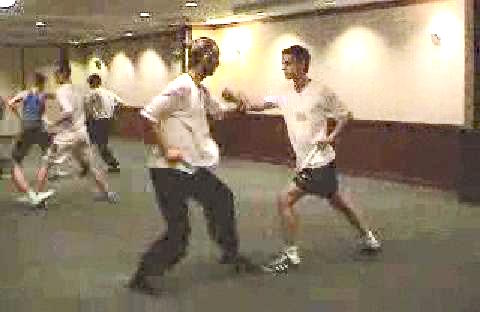 Attacking in a Coherent, Concerted Manner
Attacking in a Coherent, Concerted Manner
Can you find out what sequences the participants use in their sequence continuation method? In today's sparring when people usually fight randomly, if you attack your opponent in a coherent, concerted manner, it is likely he would be quite helpless.
 Sequence Sparring and Random Sparring
Sequence Sparring and Random Sparring
Participants are quite effective in their sparring, which is not pre-arranged. Would they still be effective if their opponents do not use kungfu patterns for fighting, or their opponents fight randomly. Of course. Sequence sparring is at least two levels above random sparring.
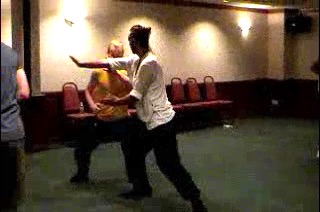 Sequence 8: Horizontally Sweep a Thousand Armies
Sequence 8: Horizontally Sweep a Thousand Armies
Here is Sequence 8, which is called “Horizontally Sweeping a Thousand Armies”. You make a move to tempt your opponent to respond. When he counter-attacks with a punch or extend his hand giving you some target, you chop his arm with a “Single Knife”, and immediately chop his neck with a “Horizontal Sweep”. This is an example of employing tactics and the relevant techniques to implement the tactics.
 Techniques and Tactics embedded in Patterns and Sequences
Techniques and Tactics embedded in Patterns and Sequences
What would you do if a skillful opponent applies such tactics and techniques on you? Just respond the way you have been trained! Kungfu patterns summarize some of the best techniques, and combat sequences summarize some of the best tactics past masters accumulated over many centuries from direct fighting experiences.
 Depth of Shaolin Tactics and Techniques
Depth of Shaolin Tactics and Techniques
Here is an application of good tactics and techniques. These techniques and tactics were discovered by past masters in actual fighting. Can you find good tactics and techniques in the sequence?
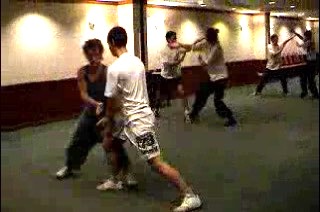 Tempting an Opponent to Expose Himself
Tempting an Opponent to Expose Himself
These sequences and patterns have been integrated so well that they just flow spontaneously according to the situations at hand. Yet they embed profound techniques and tactics. The thrust punch with an open chest, for example, is a good tactic to tempt an opponent to attack so that you can strike his ribs.
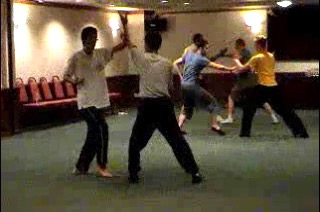 Overcoming Two Major Problems of Free Sparring
Overcoming Two Major Problems of Free Sparring
Here the participants spar spontaneously without predetermined movements. They have overcome the two major problems facing kungfu practitioners attempting free sparring, namely what patterns to use next in attack, and how to respond correctly and spontaneously to an opponent's attacks.
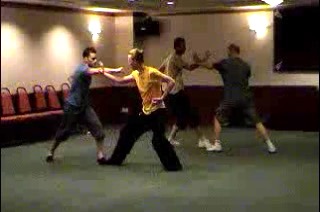 The Secrets of Combat Sequence Training
The Secrets of Combat Sequence Training
How does one use kungfu techniques to attack an opponent without hesitating to think what techniques to use? And how does one use kungfu techniques to respond correctly and spontaneously to non-predetermined attacks? The secrets lie in combat sequence training.
 Can You be Effective against an Opponent using Non-Kungfu Forms?
Can You be Effective against an Opponent using Non-Kungfu Forms?
Would the participants be able to respond correctly and spontaneous if an opponent does not use kungfu forms? The answer is yes, although initially kungfu students would need some practice to adjust themselves to the new visual impact. Why, then, most kungfu practitioners cannot spar effectively against Boxers? The answer is because most kungfu practitioners have never learnt and practiced using kungfu for combat.
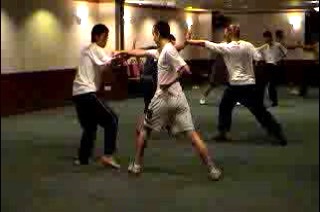 Can You Handle Other Forms of Attack?
Can You Handle Other Forms of Attack?
Can the participants be effective against kicks and other forms of attacks? At this stage of training, the answer is no, because they have not been trained to do so yet. So far the training is focused on strikes. Kicks will be dealt with in the next stage.
Using Techniques and Tactics in Kungfu Sparring from Wong Kiew Kit on Vimeo.
1. Stances: the Foundation for Internal Force and Combat Efficiency
2. Footwork Secrets for Health, Efficiency and Elegance
3. Moving into a Same Direction using Different Ways to Gain Advantages
4. Picture-Perfect Forms and Flowing Movements
5. From Random Fighting to Patterns, and from Patterns to Sequences and Sets
6. One-Step Sparring to Develop Combat Skills
7. From Pre-Arranged Sparring to Guided Sparring
8. Using Techniques and Tactics in Sparring
9. The Five Basic Kicks
10. The Secrets of Side Kicks and Continuous Cannons
11. How You may Defeat Opponents Experienced in Random Free Sparring
12. How Would a Fragile Girl Counter a Powerful Sweeping Kick from a Muay Thai Fighter?
13. Shaolin Felling Techniques and their Defences
14. Safety First Before Executing Felling Techniques
15. From Combat Sequences to Free Sparring
16. Sixteen Combat Sequences and Five Kungfu Sets
17. Surprise your Attacker with a Counter-Attack
18. Working out Ways to Fight a Boxer
19. Effective Tactics and Techniques against Boxers
20. From Gross Outline to Fine Details
21. Exploiting Advantage to Clinch Victory
22. Variety of Kungfu Techniques against Boxers
23. Analysis of Techniques Used against Boxers
24. Using Shaolin Kunfu against Boxing in Free Sparring
25. Effective Shaolin Tactics and Techniques against Kick-Boxing
26. Shaolin Kungfu against Kick-Boxing in Free Sparring
27. How to Handle a Karate Exponent
28. How to Handle a Taekwondo Exponent
29. How to Handle a Wrestling Exponent
30. Understanding the Typical Attacks of Muay Thai Fighters
31. Grandmaster Ho's Secrets in Countering Muay Thai Fighters
32. First Avoid Defeat, Then Secure Victory
33. Counteroing the Elbow and Knee Attacks of Muay Thai Fighters
